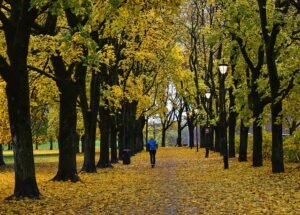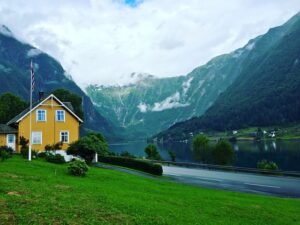

Discussing Your Hobbies in Norwegian: A Comprehensive Guide
Table of Contents
ToggleIntroduction
Talking about hobbies is an essential part of social interaction and a great way to get to know others. Whether you’re learning Norwegian as a foreign language or looking to improve your conversational skills, discussing your hobbies can open doors to meaningful conversations and new friendships. This comprehensive guide will walk you through the process of talking about your interests in Norwegian, from basic vocabulary to more advanced expressions and cultural nuances.
Learning to discuss your hobbies in Norwegian is an excellent way to enhance your language skills. If you’re looking to improve your Norwegian language abilities, consider joining the group Norwegian classes at NLS Norwegian Language School in Oslo. You can find more information and sign up at https://nlsnorwegian.no/group-norwegian-classes/.
1. Basic Vocabulary for Hobbies
Before we dive deeper into the topic, let’s look at some essential words and phrases related to hobbies in Norwegian:
- Hobby (plural: hobbyer) = hobby
- Interesse (plural: interesser) = interest
- Fritidsaktivitet = leisure activity
- Å like = to like
- Å elske = to love
- Å nyte = to enjoy
- Å drive med = to engage in, to do (as a hobby)
- På fritiden = in one’s spare time
- Lidenskapelig = passionate
- Fritidssysler = pastimes
- Å tilbringe tid = to spend time
- Å ha det gøy = to have fun
- Å slappe av = to relax
- Å utforske = to explore
Example sentences:
- Min hobby er fotografering. (My hobby is photography.)
- Jeg har mange interesser. (I have many interests.)
- På fritiden liker jeg å lese bøker. (In my spare time, I like to read books.)
- Jeg driver med maling som en fritidsaktivitet. (I engage in painting as a leisure activity.)
- Han er lidenskapelig opptatt av sjakk. (He is passionate about chess.)
- Hvilke fritidssysler har du? (What pastimes do you have?)
- Jeg liker å tilbringe tid i naturen. (I like to spend time in nature.)
- Å spille gitar hjelper meg å slappe av. (Playing guitar helps me relax.)
- Hun elsker å utforske nye steder. (She loves to explore new places.)
2. Common Hobbies and Their Norwegian Names
Here’s an expanded list of popular hobbies with their Norwegian names:
- Lesing = reading
- Maling = painting
- Fotografering = photography
- Hagearbeid = gardening
- Matlaging = cooking
- Strikking = knitting
- Sykling = cycling
- Fiske = fishing
- Dataspill = video gaming
- Reising = traveling
- Fjellklatring = mountain climbing
- Skigåing = skiing
- Svømming = swimming
- Dansing = dancing
- Samling (e.g., frimerker) = collecting (e.g., stamps)
- Løping = running
- Yoga = yoga
- Meditasjon = meditation
- Scrapping = scrapbooking
- Sying = sewing
- Snekring = woodworking
- Keramikk = pottery
- Fuglekikking = birdwatching
- Skateboardkjøring = skateboarding
- Surfing = surfing
- Musikk (spille et instrument) = music (playing an instrument)
- Teater = theater
- Skriving = writing
- Tegning = drawing
- Friluftsliv = outdoor life activities
It’s worth noting that some English words for hobbies are also used in Norwegian, especially for newer or more specialized activities. For example:
- Blogging = blogging
- Podcasting = podcasting
- Cosplay = cosplay
- DIY (Do-It-Yourself) projects = DIY-prosjekter
3. How to Talk About Your Hobbies
When discussing your hobbies in Norwegian, you can use various sentence structures to express your interests and activities. Here are some common patterns with examples:
a) Jeg + verb + å + infinitive Example: Jeg liker å lese bøker. (I like to read books.) Jeg elsker å fotografere natur. (I love to photograph nature.)
b) Min hobby er + noun Example: Min hobby er fotografering. (My hobby is photography.) Min største interesse er matlaging. (My biggest interest is cooking.)
c) På fritiden + verb + jeg Example: På fritiden sykler jeg ofte. (In my spare time, I often cycle.) På fritiden lager jeg smykker. (In my spare time, I make jewelry.)
d) Jeg er interessert i + noun Example: Jeg er interessert i matlaging. (I am interested in cooking.) Jeg er veldig interessert i kunsthistorie. (I’m very interested in art history.)
e) Jeg driver med + noun Example: Jeg driver med fjellklatring. (I engage in mountain climbing.) Jeg driver mye med hagearbeid om sommeren. (I do a lot of gardening in the summer.)
f) Å + infinitive + er min lidenskap Example: Å danse er min lidenskap. (Dancing is my passion.) Å lage mat er min største lidenskap. (Cooking is my greatest passion.)
g) Jeg bruker mye tid på å + infinitive Example: Jeg bruker mye tid på å strikke. (I spend a lot of time knitting.) Jeg bruker mye tid på å utforske nye stier i skogen. (I spend a lot of time exploring new trails in the forest.)
Let’s look at some more detailed examples:
“Hei! Jeg heter Maria, og min største hobby er fotografering. Jeg elsker å fange øyeblikk og skjønnheten i naturen. På fritiden drar jeg ofte ut i skogen eller til kysten for å ta bilder. Jeg er også veldig interessert i bilderedigering og bruker mye tid på å forbedre bildene mine digitalt. Fotografering gir meg muligheten til å se verden på en ny måte og dele mine opplevelser med andre.”
(Hi! My name is Maria, and my biggest hobby is photography. I love capturing moments and the beauty of nature. In my spare time, I often go to the forest or the coast to take pictures. I’m also very interested in photo editing and spend a lot of time improving my images digitally. Photography gives me the opportunity to see the world in a new way and share my experiences with others.)
“God dag! Jeg er Lars, og jeg er lidenskapelig opptatt av matlaging. Jeg liker å eksperimentere med nye oppskrifter og ingredienser. I helgene bruker jeg ofte flere timer på kjøkkenet for å lage spennende retter til familie og venner. Å lage mat er ikke bare en hobby for meg, det er en måte å uttrykke kreativitet og kjærlighet på. I tillegg driver jeg med hagearbeid, så jeg dyrker mine egne urter og grønnsaker til matlaging. Det gir meg en dypere forståelse og verdsettelse av ingrediensene jeg bruker.”
(Good day! I’m Lars, and I’m passionate about cooking. I like to experiment with new recipes and ingredients. On weekends, I often spend several hours in the kitchen making exciting dishes for family and friends. Cooking is not just a hobby for me; it’s a way to express creativity and love. In addition, I do gardening, so I grow my own herbs and vegetables for cooking. It gives me a deeper understanding and appreciation of the ingredients I use.)
4. Expressing Feelings and Opinions About Hobbies
To make conversations about hobbies more engaging, it’s useful to be able to express feelings and opinions. Here are some helpful phrases with examples:
- Jeg synes … er spennende/interessant/morsomt. (I think … is exciting/interesting/fun.) Example: Jeg synes fotografering er utrolig spennende fordi hvert bilde forteller en unik historie. (I think photography is incredibly exciting because each picture tells a unique story.)
- … gir meg glede/tilfredsstillelse. (… gives me joy/satisfaction.) Example: Å se plantene mine vokse gir meg stor glede og tilfredsstillelse. (Seeing my plants grow gives me great joy and satisfaction.)
- Jeg blir avslappet/energisk når jeg … (I become relaxed/energetic when I …) Example: Jeg blir veldig avslappet når jeg maler, det er nesten som en form for meditasjon for meg. (I become very relaxed when I paint; it’s almost like a form of meditation for me.)
- Det beste med … er … (The best thing about … is …) Example: Det beste med å lage musikk er muligheten til å uttrykke følelser gjennom lyd. (The best thing about making music is the opportunity to express emotions through sound.)
- Jeg drømmer om å … (I dream of …) Example: Jeg drømmer om å publisere min egen kokebok en dag. (I dream of publishing my own cookbook one day.)
- Min lidenskap for … begynte da … (My passion for … began when …) Example: Min lidenskap for strikking begynte da bestemoren min lærte meg det som barn. (My passion for knitting began when my grandmother taught me as a child.)
- Å drive med … hjelper meg å … (Engaging in … helps me to …) Example: Å drive med yoga hjelper meg å finne balanse i en travel hverdag. (Engaging in yoga helps me find balance in a busy everyday life.)
- Jeg føler meg … når jeg … (I feel … when I …) Example: Jeg føler meg fri og levende når jeg surfer. (I feel free and alive when I surf.)
- … har lært meg mye om … (… has taught me a lot about …) Example: Hagearbeid har lært meg mye om tålmodighet og naturens sykluser. (Gardening has taught me a lot about patience and nature’s cycles.)
Here are some more elaborate examples:
“Jeg synes fjellklatring er utrolig spennende. Det gir meg en følelse av frihet og mestring. Når jeg står på toppen av et fjell, føler jeg meg både avslappet og energisk på samme tid. Det beste med fjellklatring er utfordringen og de vakre utsiktene man får oppleve. Hver klatring lærer meg noe nytt om mine egne grenser og om naturen rundt meg. Jeg drømmer om å bestige noen av verdens høyeste fjell en dag.”
(I think mountain climbing is incredibly exciting. It gives me a sense of freedom and accomplishment. When I stand on top of a mountain, I feel both relaxed and energetic at the same time. The best thing about mountain climbing is the challenge and the beautiful views you get to experience. Each climb teaches me something new about my own limits and the nature around me. I dream of climbing some of the world’s highest mountains one day.)
“Min lidenskap for strikking begynte da bestemoren min lærte meg det som barn. Jeg blir veldig avslappet når jeg strikker, og det gir meg stor tilfredsstillelse å se et prosjekt ta form. Strikking har lært meg mye om tålmodighet og kreativitet. Det beste med denne hobbyen er at jeg kan skape unike, personlige gaver til venner og familie. Jeg drømmer om å designe mine egne strikkemønstre en dag og kanskje til og med åpne en liten garnbutikk.”
(My passion for knitting began when my grandmother taught me as a child. I become very relaxed when I knit, and it gives me great satisfaction to see a project take shape. Knitting has taught me a lot about patience and creativity. The best thing about this hobby is that I can create unique, personal gifts for friends and family. I dream of designing my own knitting patterns one day and maybe even opening a small yarn shop.)
5. Asking Questions About Others’ Hobbies
To engage in conversations about hobbies, it’s important to be able to ask questions to others. Here are some useful questions with example dialogues:
- Hva liker du å gjøre på fritiden? (What do you like to do in your spare time?)
- Har du noen hobbyer? (Do you have any hobbies?)
- Hva er din favorittaktivitet? (What is your favorite activity?)
- Hvor ofte driver du med …? (How often do you engage in …?)
- Når begynte du med …? (When did you start …?)
- Hva liker du best med …? (What do you like best about …?)
- Hvordan ble du interessert i …? (How did you become interested in …?)
- Er det vanskelig å lære seg …? (Is it difficult to learn …?)
- Hva slags utstyr trenger man for å …? (What kind of equipment do you need to …?)
- Kan du anbefale noen gode ressurser for å lære mer om …? (Can you recommend any good resources to learn more about …?)
Example dialogue:
A: Hei! Jeg har lagt merke til at du ofte har med deg et kamera. Er fotografering en hobby for deg? (Hi! I’ve noticed that you often have a camera with you. Is photography a hobby for you?)
B: Ja, det stemmer! Jeg elsker å ta bilder, spesielt av natur og arkitektur. (Yes, that’s right! I love taking pictures, especially of nature and architecture.)
A: Så spennende! Hvor lenge har du drevet med fotografering? (How exciting! How long have you been doing photography?)
B: Jeg begynte for alvor for omtrent fem år siden, men jeg har alltid vært interessert i å fange øyeblikk på film. (I started seriously about five years ago, but I’ve always been interested in capturing moments on film.)
A: Hva liker du best med denne hobbyen? (What do you like best about this hobby?)
B: Det jeg liker best er muligheten til å se verden på en ny måte. Gjennom linsen oppdager jeg detaljer jeg ellers ville ha oversett. (What I like best is the opportunity to see the world in a new way. Through the lens, I discover details I would otherwise have overlooked.)
A: Det høres fascinerende ut! Har du noen tips til noen som ønsker å begynne med fotografering? (That sounds fascinating! Do you have any tips for someone who wants to start with photography?)
B: Absolutt! Mitt beste råd er å begynne med det kameraet du har, selv om det bare er en mobiltelefon. Øv deg på å se etter interessante komposisjoner og lys i hverdagen. Og ikke vær redd for å eksperimentere! (Absolutely! My best advice is to start with the camera you have, even if it’s just a mobile phone. Practice looking for interesting compositions and light in everyday life. And don’t be afraid to experiment!)
A: Takk for tipsene! Kanskje jeg skal prøve meg på fotografering selv. (Thanks for the tips! Maybe I’ll try photography myself.)
6. Cultural Aspects of Hobbies in Norway
Understanding the cultural context of hobbies in Norway can enhance your conversations and help you connect with locals. Here are some popular Norwegian hobbies and their cultural significance:
Friluftsliv (Outdoor Life)
Friluftsliv is more than just a hobby in Norway; it’s a way of life. This term encompasses a wide range of outdoor activities and a deep connection to nature. Norwegians have a saying, “Det finnes ikke dårlig vær, bare dårlige klær” (There’s no such thing as bad weather, only bad clothing), which reflects their commitment to outdoor activities regardless of the weather.
Popular friluftsliv activities include:
- Hiking (turgåing)
- Cross-country skiing (langrenn)
- Fishing (fiske)
- Berry and mushroom picking (bær- og sopplukking)
- Camping (camping/telting)
Example: “Jeg er veldig glad i friluftsliv. Om sommeren går jeg ofte på fjelltur, og om vinteren står jeg på ski hver helg. Det gir meg en fantastisk følelse av frihet og nærhet til naturen.”
(I’m very fond of outdoor life. In the summer, I often go hiking in the mountains, and in the winter, I go skiing every weekend. It gives me an amazing feeling of freedom and closeness to nature.)
Dugnad
Dugnad is a form of voluntary work done as a community. While not strictly a hobby, it’s an important cultural concept that often involves leisure activities. Dugnads can be organized for sports clubs, schools, or local communities, and they often combine work with social interaction.
Example: “I vår lokale fotballklubb har vi dugnad to ganger i året. Vi maler klubbhuset, rydder banen og har det hyggelig sammen. Det er en fin måte å bidra til fellesskapet på.”
(In our local football club, we have dugnad twice a year. We paint the clubhouse, clean up the field, and have a good time together. It’s a nice way to contribute to the community.)
Hytte Culture
Many Norwegians have cabins (hytter) where they spend weekends and holidays. This is deeply ingrained in Norwegian culture and often involves various outdoor activities and hobbies.
Example: “Vi har en hytte i fjellet hvor vi tilbringer mange helger. Der kan vi gå på ski om vinteren og fiske i den nærliggende elven om sommeren. Det er vår måte å koble av fra bylivet på.”
(We have a cabin in the mountains where we spend many weekends. There we can go skiing in the winter and fish in the nearby river in the summer. It’s our way of disconnecting from city life.)
Sports
Sports play a significant role in Norwegian culture, both as hobbies and spectator activities. Some popular sports include:
- Cross-country skiing (langrenn)
- Football (soccer) (fotball)
- Handball (håndball)
- Biathlon (skiskyting)
- Ice skating (skøyting)
Example: “Jeg har spilt håndball siden jeg var liten. Det er en stor del av norsk idrettskultur, og jeg elsker både å spille selv og å se på landslaget når de konkurrerer internasjonalt.”
(I’ve been playing handball since I was little. It’s a big part of Norwegian sports culture, and I love both playing myself and watching the national team when they compete internationally.)
7. Advanced Vocabulary for Discussing Hobbies
As you become more proficient in Norwegian, you may want to use more advanced vocabulary to discuss your hobbies. Here are some examples with sentences:
- Å fordype seg i = to immerse oneself in Example: Jeg har fordypet meg i fotografering det siste året og lært mye om komposisjon og lyssetting. (I have immersed myself in photography over the past year and learned a lot about composition and lighting.)
- Å mestre = to master Example: Det tok meg mange år å mestre kunsten å strikke kompliserte mønstre. (It took me many years to master the art of knitting complex patterns.)
- Å utvikle ferdigheter = to develop skills Example: Gjennom min hobby har jeg utviklet ferdigheter innen problemløsning og kreativ tenkning. (Through my hobby, I have developed skills in problem-solving and creative thinking.)
- Å finne inspirasjon = to find inspiration Example: Jeg finner ofte inspirasjon til mine malerier i naturen rundt meg. (I often find inspiration for my paintings in the nature around me.)
- Å overvinne utfordringer = to overcome challenges Example: En av de største gledene ved fjellklatring er å overvinne utfordringer og nå toppen. (One of the greatest joys of mountain climbing is overcoming challenges and reaching the summit.)
- Å dele erfaringer = to share experiences Example: Jeg liker å dele mine erfaringer med andre hobbykokker gjennom min matblogg. (I like to share my experiences with other hobby chefs through my food blog.)
- Å utforske grenser = to explore boundaries Example: Gjennom min interesse for ekstremsport utforsker jeg stadig mine egne grenser. (Through my interest in extreme sports, I constantly explore my own boundaries.)
- Å forfine teknikker = to refine techniques Example: Etter mange års øvelse fortsetter jeg å forfine mine teknikker innen keramikk. (After many years of practice, I continue to refine my techniques in ceramics.)
- Å dyrke en lidenskap = to cultivate a passion Example: Å dyrke min lidenskap for musikk har gitt livet mitt mer mening og glede. (Cultivating my passion for music has given my life more meaning and joy.)
- Å balansere hobby og arbeid = to balance hobby and work Example: Det kan være utfordrende å balansere min tidkrevende hobby med en krevende jobb. (It can be challenging to balance my time-consuming hobby with a demanding job.)
8. Discussing the Benefits of Hobbies
When talking about your hobbies in Norwegian, it’s valuable to be able to discuss the benefits they bring to your life. Here are some phrases and examples:
- Å redusere stress = to reduce stress Example: Å male hjelper meg å redusere stress etter en lang arbeidsdag. (Painting helps me reduce stress after a long workday.)
- Å forbedre mental helse = to improve mental health Example: Min hobby har spilt en viktig rolle i å forbedre min mentale helse og generelle velvære. (My hobby has played an important role in improving my mental health and overall well-being.)
- Å øke selvtillit = to increase self-confidence Example: Å mestre nye ferdigheter i min hobby har økt min selvtillit på andre områder av livet. (Mastering new skills in my hobby has increased my self-confidence in other areas of life.)
- Å møte likesinnede = to meet like-minded people Example: Gjennom min hobby har jeg møtt mange likesinnede og dannet verdifulle vennskap. (Through my hobby, I have met many like-minded people and formed valuable friendships.)
- Å stimulere kreativitet = to stimulate creativity Example: Min interesse for fotografi stimulerer min kreativitet og får meg til å se verden på nye måter. (My interest in photography stimulates my creativity and makes me see the world in new ways.)
- Å lære nye ferdigheter = to learn new skills Example: Hobbyen min har lært meg mange nye ferdigheter, som tålmodighet og problemløsning. (My hobby has taught me many new skills, such as patience and problem-solving.)
9. Talking About Future Plans Related to Your Hobbies
Discussing your future plans or goals related to your hobbies can make for interesting conversation. Here are some phrases and examples:
- Jeg planlegger å … = I plan to … Example: Jeg planlegger å delta i et malekurs til neste år for å forbedre teknikkene mine. (I plan to participate in a painting course next year to improve my techniques.)
- Mitt mål er å … = My goal is to … Example: Mitt mål er å fullføre et maraton innen de neste to årene. (My goal is to complete a marathon within the next two years.)
- Jeg drømmer om å … = I dream of … Example: Jeg drømmer om å åpne mitt eget keramikkverksted en dag. (I dream of opening my own pottery workshop one day.)
- I fremtiden håper jeg å … = In the future, I hope to … Example: I fremtiden håper jeg å kunne reise verden rundt og fotografere ulike kulturer. (In the future, I hope to be able to travel around the world and photograph different cultures.)
- Jeg vurderer å … = I’m considering … Example: Jeg vurderer å starte en YouTube-kanal for å dele mine matlagingstips. (I’m considering starting a YouTube channel to share my cooking tips.)
Conclusion
Discussing hobbies in Norwegian is an excellent way to improve your language skills and connect with others. By mastering the vocabulary, sentence structures, and cultural aspects related to hobbies, you’ll be able to engage in meaningful conversations and express your interests more effectively.
Remember, practice is key to improving your language skills. If you’re looking to enhance your Norwegian language abilities, consider joining the group Norwegian classes at NLS Norwegian Language School in Oslo. You can find more information and sign up at https://nlsnorwegian.no/group-norwegian-classes/.
By immersing yourself in the language and culture, you’ll not only improve your ability to discuss hobbies but also gain a deeper understanding of Norwegian society and way of life. Hobbies are an integral part of Norwegian culture, reflecting values such as connection to nature, community spirit, and personal development.
Whether you’re passionate about outdoor activities like hiking and skiing, creative pursuits like painting and photography, or any other hobby, being able to discuss these interests in Norwegian will enrich your conversations and help you form deeper connections with Norwegian speakers.
So, don’t hesitate to start practicing and sharing your interests in Norwegian today! Engage in conversations, join clubs or groups related to your hobbies, and seek out opportunities to use your Norwegian skills in real-life situations. With time and practice, you’ll find yourself confidently discussing your passions and discovering new ones in the beautiful Norwegian language.
If you want to learn Norwegian, you can register for classes here. We look forward to hearing from you and helping you become fluent in Norwegian.





